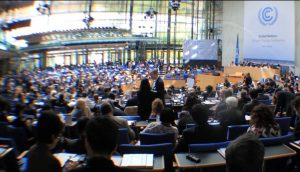Once again, negotiators at a UN climate meeting find themselves staring at a long and contradictory text that will require major – and so far indeterminate – compromises if the Paris climate summit in December is to agree to meaningful cuts in greenhouse gas emissions.
The cuts proposed so far in 40 or so national climate plans submitted to the UN fall well short of what scientists say is required to put the world on a path to avoid a rise of global temperatures beyond 2C, an outcome that is likely to further anger countries most vulnerable to climate change.
In addition to developed countries that grew rich on the burning of coal over the past several centuries, the ire of small island states may also be directed at China, which has said little about its emissions trajectory following a planned 2030 peak.
“For the future agreement to be science based, it is important that it includes a long term mitigation target in line with and could operationalise the 2C target. China has not very actively engaged on this issue, aside from a general resistance,” said Li Shuo of Greenpeace, who monitors China’s participation in UN climate talks.
The world’s largest emitter of greenhouse gases is expected to submit its national climate plan (known in UN jargon as an Intended Nationally Determined Contribution or INDC) sometime this month.
However China is unlikely to provide much detail on future carbon cuts beyond the 2030 peak outlined in last year’s joint climate plan with the US.
A so-called ‘ratchet’ or review mechanism that will require emissions cuts to be deepened every five years is viewed as essential for the Paris summit to be deemed any type of success.
But so far, Chinese negotiators have opposed such an approach.
“It is crucial that China finds a way to address the ratchet mechanism, especially given that the latest decline in coal consumption will give the country plenty of space to pursue higher ambition post-2020,” Li added.
In general, progress at the Bonn talks is likely, at best, to be gradual, rather than delivering bombshell, headline-grabbing breakthroughs.
“While delegates – and particular the French hosts of December’s Paris summit – will want to see a shrinking and distilling of the negotiating text, there’s unlikely to be a ‘reality check’ moment,” said climate policy specialist Liz Gallagher at consultants E3G.
“That is more likely to come at later meetings, but delegates will need to leave Bonn with better options in the negotiating text,” she added.
In theory, additional pressure for progress at the meeting in Bonn would be expected to come as the leaders of the G7 gather next week for their annual meeting, which this year is also hosted by Germany.
In Bavaria, Chancellor Angela Merkel will chair a G7 meeting where climate change, and in particular climate finance, is unusually high on the agenda.
But, platitudes at previous leaders’ summits have failed to translate into tangible action in the UN arena.
In addition to removing multiple caveats and opposing positions from the negotiating text, some of which are judged to be on the more trivial end of the scale, the two-week Bonn meeting will need to try and overcome the more cumbersome and longtstanding obstacles to progress.
Learning the lessons of Copenhagen
The acrimonious Copenhagen climate summit in 2009 serves a template to avoid in 2015.
The more meaty issues at Bonn include the extent to which developing countries should be responsible for slowing their emissions, how cuts in greenhouse gases should be compared and measured, the legal status of a new agreement, and the amount of money that richer countries should raise for low carbon energy and technology that will help the world’s most vulnerable countries deal with the impacts of climate change.
At present, the negotiating text stands at 90 pages, and will need to be shrunk and merged with clear and agreed principles as a basis for ministers to negotiate in Paris.
“There’s very little time left. You have an enormous number of countries at the table with an enormous number of proposals to be considered and almost no time to consider them,” said Yvo de Boer, the UN’s former climate chief, to the Financial Times last week.
Compared with the chaotic negotiations before and during Copenhagen, signs of compromise this time around are much stronger, says the current UN climate head Cristiana Figueres, and last year’s landmark agreement between China and the US may help form the basis of important relationships elsewhere.
Brazilian proposal
Brazil’s proposal on how to solve the longstanding conundrum on how to classify rich, middle-income, and fast-developing but mainly poor countries has been touted as a potential basis for a deal, but so far India has led developing countries in resisting changes to old classifications laid down by the Kyoto Protocol.
“Some G77 countries are receptive to the Brazil proposal, but it’s not likely to go down well with US Congress, which wants big developing world emitters to commit to slowing emissions along similar terms as the US,” E3G’s Gallagher adds.
It also remains uncertain how the Brazilian proposal would be integrated in the negotiating text.
What is clear, however, is that the 190 countries are coming under increasing pressure to smooth out the rocky road to Paris by striking agreements on the contentious issues. Few signs have emerged so far that this will happen over the next two weeks in Bonn.







